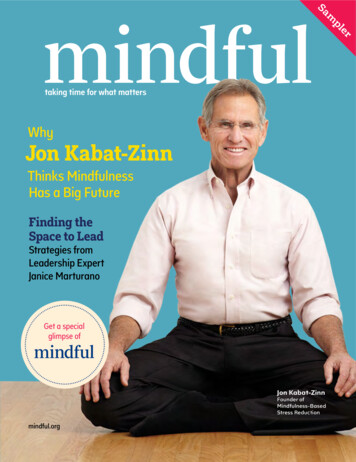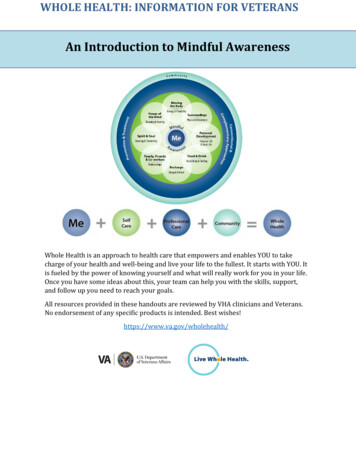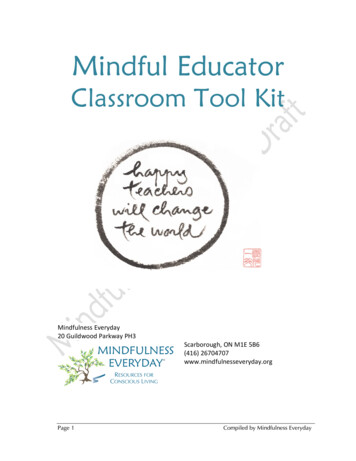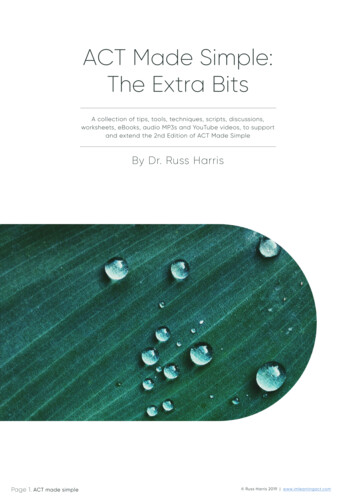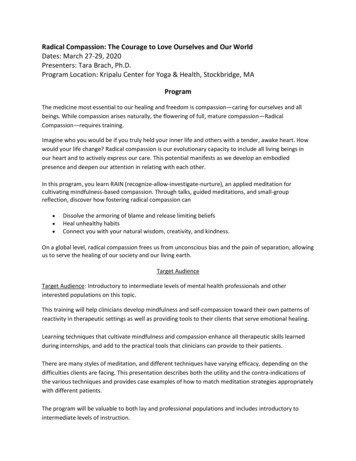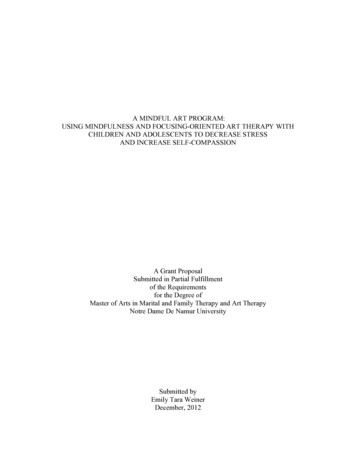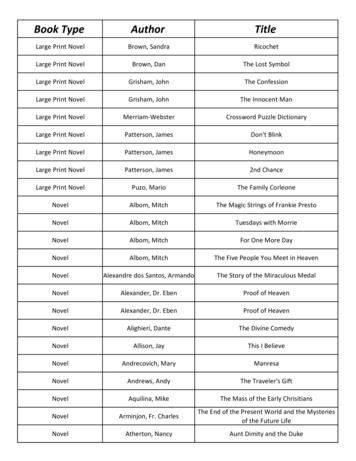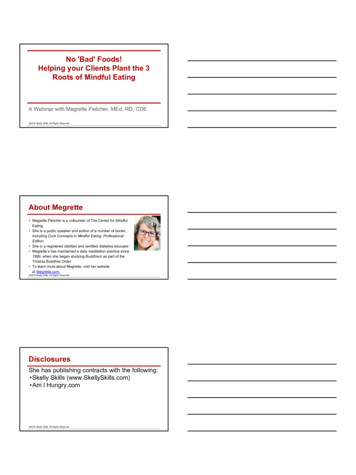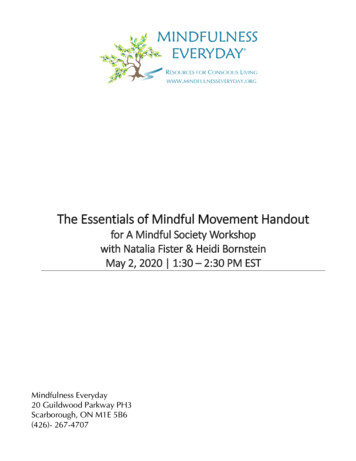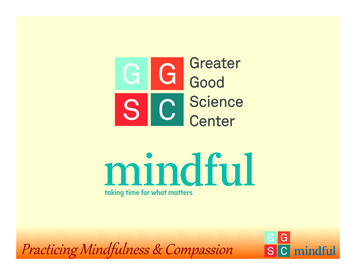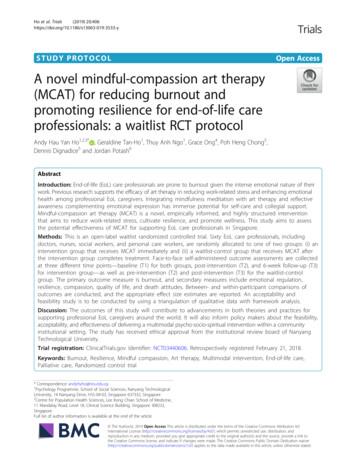
Transcription
Ho et al. Trials(2019) DY PROTOCOLOpen AccessA novel mindful-compassion art therapy(MCAT) for reducing burnout andpromoting resilience for end-of-life careprofessionals: a waitlist RCT protocolAndy Hau Yan Ho1,2,3* , Geraldine Tan-Ho1, Thuy Anh Ngo1, Grace Ong4, Poh Heng Chong5,Dennis Dignadice5 and Jordan Potash6AbstractIntroduction: End-of-life (EoL) care professionals are prone to burnout given the intense emotional nature of theirwork. Previous research supports the efficacy of art therapy in reducing work-related stress and enhancing emotionalhealth among professional EoL caregivers. Integrating mindfulness meditation with art therapy and reflectiveawareness complementing emotional expression has immense potential for self-care and collegial support.Mindful-compassion art therapy (MCAT) is a novel, empirically informed, and highly structured interventionthat aims to reduce work-related stress, cultivate resilience, and promote wellness. This study aims to assessthe potential effectiveness of MCAT for supporting EoL care professionals in Singapore.Methods: This is an open-label waitlist randomized controlled trial. Sixty EoL care professionals, includingdoctors, nurses, social workers, and personal care workers, are randomly allocated to one of two groups: (i) anintervention group that receives MCAT immediately and (ii) a waitlist-control group that receives MCAT afterthe intervention group completes treatment. Face-to-face self-administered outcome assessments are collectedat three different time points—baseline (T1) for both groups, post-intervention (T2), and 6-week follow-up (T3)for intervention group—as well as pre-intervention (T2) and post-intervention (T3) for the waitlist-controlgroup. The primary outcome measure is burnout, and secondary measures include emotional regulation,resilience, compassion, quality of life, and death attitudes. Between- and within-participant comparisons ofoutcomes are conducted, and the appropriate effect size estimates are reported. An acceptability andfeasibility study is to be conducted by using a triangulation of qualitative data with framework analysis.Discussion: The outcomes of this study will contribute to advancements in both theories and practices forsupporting professional EoL caregivers around the world. It will also inform policy makers about the feasibility,acceptability, and effectiveness of delivering a multimodal psycho-socio-spiritual intervention within a communityinstitutional setting. The study has received ethical approval from the institutional review board of NanyangTechnological University.Trial registration: ClinicalTrials.gov Identifier: NCT03440606. Retrospectively registered February 21, 2018.Keywords: Burnout, Resilience, Mindful compassion, Art therapy, Multimodal intervention, End-of-life care,Palliative care, Randomized control trial* Correspondence: andyhyho@ntu.edu.sg1Psychology Programme, School of Social Sciences, Nanyang TechnologicalUniversity, 14 Nanyang Drive, HSS-04-03, Singapore 637332, Singapore2Centre for Population Health Sciences, Lee Kong Chian School of Medicine,11 Mandalay Road, Level 18, Clinical Science Building, Singapore 308232,SingaporeFull list of author information is available at the end of the article The Author(s). 2019 Open Access This article is distributed under the terms of the Creative Commons Attribution 4.0International License (http://creativecommons.org/licenses/by/4.0/), which permits unrestricted use, distribution, andreproduction in any medium, provided you give appropriate credit to the original author(s) and the source, provide a link tothe Creative Commons license, and indicate if changes were made. The Creative Commons Public Domain Dedication o/1.0/) applies to the data made available in this article, unless otherwise stated.
Ho et al. Trials(2019) 20:406BackgroundProfessional caregivers working in the fields of end-oflife (EoL), palliative, and bereavement care are regularlyexposed to immense stress from intense emotional engagements with dying patients and bereaved families [1].The constant exposure to death, grief, and loss can result in burnout [2, 3], “a state of exhaustion in whichone is cynical about the value of one’s occupation anddoubtful of one’s capacity to perform” [4]. Burnout combined with the vicarious trauma experienced by professional EoL caregivers through the deaths of theirpatients can further result in compassion fatigue, “an extreme state of tension and preoccupation with the suffering of those being helped to the degree that it can createa secondary traumatic stress for the helper” [5]. If notproperly managed, burnout and compassion fatigue canbe detrimental to the physical and mental health of professional EoL caregivers, and effects can trickle down topatients, colleagues, family, and friends and pose threatsto quality of patient care and quality of personal life.A recent study found that about 9% of the 7905 surgeons surveyed in the US reported having made a majormedical error in the previous 3 months [6] and thatstress and burnout were the principal culprits of safetyrelated quality-of-care concerns [7]. Another study reported that, owing to stress and burnout, the turnoverrate of in-patient hospice workers stands at an alarming30% and reaches as high as 60% for homecare workers[8]. Professional EoL caregiving, by its very nature,necessitates high levels of psycho-socio-emotional competence and therefore adequate support to professionalEoL caregivers would entail clinical supervisions orinterventions that aim to enhance their sense of autonomy and empathic capacity while providing avenuesto cultivate resilience, foster coherence, and achievemeaning-making [9]. Of particular importance is establishing a communal platform for EoL care professionals to periodically reflect on their own attitudes,feelings, and anxieties related to death and loss [10]while being able to express their thoughts to teammembers for building mutual respect, understanding,and communal support [11].Clinical supervision and art therapyAlthough supervision has been shown to be effective inreducing fatigue among hospice workers [12], specific attention to emotion-focused coping skills has provenmore effective than problem-focused strategy skills in reducing burnout [13]. Emotion-focused supervision requires professionals to consider and communicatefeelings and experiences that may be difficult toverbalize. As art provides the means to express oneselfthrough images and metaphors that transcend the barriers of language [14], emotion-focused supervision thatPage 2 of 10incorporates expressive art techniques for self-reflectionand self-expression can promote and enhance the understanding of one’s emotions and stress [15]. In otherwords, supervised art therapy allows art-making and creativity to take central roles in professional selfunderstanding [16]. Several art therapists have documented how their work with EoL care professionals prevented and reduced burnout by managing stress,fostering collegial connections, emphasizing self-care,and enabling the expression of grief [17, 18].To better support professional EoL caregivers withwork-related stress in Asia, our research team had previously designed a novel art therapy–based supervisionmodel that aimed at alleviating burnout, nurturing emotional awareness, increasing collegial connections, andallowing a safe space to reflect on death and loss [19]. Theefficacy of this model was tested through a quasiexperimental design (n 132); 69 participants were enrolled in an 18-h art therapy–based supervision group(run in 6 consecutive weekly sessions lasting 3-h each)and 63 participants were enrolled in an 18-h standardskills–based supervision group (run in 3 consecuitve dailysessions lasting 6-h each). Pre- and post-intervention assessments of participants’ levels of burnout, emotionalregulation, and death attitudes revealed significant reductions in exhaustion and death anxiety as well as significantincreases in emotional awareness for those enrolled in theart therapy supervision group [20]. This study providedstrong evidence that art therapy–based supervision is effective in enhancing emotional regulation, fosteringmeaning-making, and promoting self-reflection [21].Mindfulness practice and art therapy–based supervisionIn the past decade, both researchers and clinicians havebecome increasingly interested in mindfulness practiceas studies continue to reveal its beneficial effects [22].Jon Kabat-Zinn, the foremost pioneer in the therapeuticapplication of mindfulness, defines it as “the awarenessthat emerges through paying attention on purpose, inthe present moment, and nonjudgmentally to theunfolding of experience moment to moment” [23].Bishop et al. elaborated that mindfulness is “characterized by curiosity, openness, and acceptance” [24]. Essentially, mindfulness requires individuals to practice aconcentrated focus on the present moment, to immerseoneself in his or her immediate experience, and to befreed of the destructive thoughts of future worries andpast regrets, so as to attain greater clarity, selfacceptance, and ultimately an enhanced compassion forself and others. As such, the practice of mindfulness canattune seamlessly with the emotional and spiritual needsof those who work with death and loss on a consistentbasis.
Ho et al. Trials(2019) 20:406The literature has provided a robust pool of evidencesupporting the efficacy of mindfulness practice and selfcompassion in promoting psychological well-being [25],reducing depression and anxiety [26], and enhancinghealth and overall physical functioning [27]. Despitethese positive findings, relatively little research hasattempted to integrate mindfulness practice with arttherapy to investigate their combined effects for healthelevation and stress reduction, an endeavor that warrants much greater attention [28]. The introspective andintuitive foundation of mindfulness practice can complement and facilitate the expressive and creativefoundation of art therapy, and vice versa. A uniqueamalgamation of these two modalities in the context ofsupportive intervention for EoL care professionals hasimmense potential to aid them in coping with and risingabove the trauma of loss and grief that they face on adaily basis.In essence, the integration of art therapy and mindfulness practice for addressing the self-care needs of professional EoL caregivers is a scarcely explored area inthe field of palliative, hospice, and bereavement care.Building on the clinical foundation of art therapy–basedsupervision [19–21], a novel mindful-compassion arttherapy (MCAT) for clinical supervision was developed.MCAT is a highly structured, multimodal, group-basedintervention that aims at creating a supportive platformfor EoL care professionals to deeply reflect on and creatively express their experiences of stress and self-care,competence and challenges of caregiving, and theemotionality of loss and grief. It is hypothesized thatthese interactive processes will serve to foster selfunderstanding, connectedness, internal strength, andcompassion among participants in MCAT, so as to derive a renewed appreciation of the meaning of work aswell as enhanced quality of life. The ultimate goal ofMCAT is to offer a viable supported self-care intervention to alleviate burnout and cultivate sustained resilience for EoL care professionals in the global context.Aim and objectivesBased on the Medical Research Council guidance for developing and evaluating complex intervention [29], theaims of the present study are to assess the feasibility, acceptability, and potential effectiveness of MCAT in reducing burnout and promoting resilience and holisticwellness among a purposive sample of EoL care professionals in Singapore. The specific objectives are thefollowing:a) to assess the effectiveness of MCAT for reducingburnout and negative death attitudes among EoLcare professionals, including hospice and palliativePage 3 of 10care physicians, nurses, social workers, and alliedhealth workers;b) to assess the effectiveness of MCAT for increasingEoL care professionals’ self-perceived levels of emotional regulation, resilience, compassion, and qualityof life;c) to assess the feasibility and acceptability of MCATas a supportive self-care program for EoL care professionals in the context of Singapore; andd) to develop a standardized protocol for furtherempirical research that tests interventioneffectiveness, feasibility, and acceptability of MCATin other international contexts.MethodsStudy designThis study will adopt an open-label waitlist randomizedcontrol trial (RCT) design comprising two groups: (i) anintervention group (which receives MCAT immediatelyafter baseline assessment) and (ii) a waitlist-controlgroup (which receives MCAT immediately after theintervention group completes treatment). A waitlist RCTis chosen on the basis of the ethical principle of justiceas the research team hypothesizes and anticipatesMCAT to be an effective intervention for reducing burnout and promoting wellness on the basis of previous research on the subject [19–21]. A SPIRIT checklist ofthe RCT is provided in the Additional file 1. Consentingparticipants to be recruited from one study site will berandomly allocated to one of these two groups afterbaseline assessments have been conducted. Figure 1 details the recruitment, assessment, intervention, andfollow-up procedures.Study siteStudy participants will be recruited from the largesthomecare hospice service provider and its various satellite centers across Singapore. Specifically, HCA HospiceCare (HCA) (formally known as the Hospice Care Association) is a registered charity that offers homecare anddaycare hospice services to terminally ill patients andtheir families. With one major daycare center (whichalso serves as the headquarters) and four satellite servicecenters stationed across the country, they provide nationwide coverage to all Singapore residents who have adiagnosed life-limiting illness. Apart from offering medical care to patients of all ages, HCA provides psychological support and bereavement support services forpatients and their families. HCA employs a team ofabout 60 palliative care specialists, including physicians,nurses, social workers, counselors, allied health professionals, personal care workers, and program staff, toprovide round-the-clock support to individuals and families facing the end of life.
Ho et al. Trials(2019) 20:406Page 4 of 10Fig. 1 Study design flowchartParticipantsThe sample will comprise 60 EoL care professionals. Recruitment will be conducted at all five HCA service centers (i.e., one daycare and four satellite service centers)concurrently via four non-overlapping consecutive recruitment rounds. Each round will recruit 14 or 16 participants; seven or eight participants will be randomlyassigned to one intervention group, and seven or eightparticipants will be randomly assigned to one controlgroup, adhering to a waitlist RCT design. Participants willbe recruited through the medical director of HCA and hisappointed staff with the support of a study initiation presentation conducted by the research team during a regularmonthly organization meeting with all clinical and program staff. This presentation serves as a study invitation,informing potential participants of MCAT’s basic background and essential research procedures, and includesthe request for participants to keep their MCAT experiences private until study completion so as to reduce thepotential for intervention contamination. Participants willbe invited to join the research with the understanding thatthey will be given allocated time during regular workinghours to participate in the MCAT intervention withoutany financial implications on their part; they are also assured that refusal to participate is respected and wouldnot result in any negative consequences. Inclusion criteriainclude EoL care professionals (at least 21 years old) whoare fluent in written and spoken English. Exclusion criteriainclude the inability to provide informed consent or majordepression (or other mental health conditions) or both.Written informed consent will be obtained from all participants before study participation. Participants’ confidentiality will be safeguarded under this ethical provision.RandomizationSimple randomization for each recruitment round will beconducted by using an allocation sequence based on acomputer-generated list of random numbers. Specifically,a random number sequence ranging from 1 to 14 or 16(depending on the number of participants recruited in
Ho et al. Trials(2019) 20:406Page 5 of 10each recruitment round) will be generated via ResearchRandomizer [30]. Thereafter, each participant will be randomly assigned a unique number from the sequence. Participants whose numbers occupy the first seven or eightslots in the sequence will be assigned to the interventiongroup whereas participants whose numbers occupy thelast seven or eight slots will be assigned to the waitlistcontrol group.Sample size calculationGiven an attrition rate of 15% at follow-ups, a sample of60 (N 60) will provide 80% power to detect an effectsize of 0.8 (referencing highly effective psychotherapystudies) [31] on the primary outcome measure of theMaslach Burnout Inventory–General Survey (MBI-GS)[4] between the intervention and control groups at a(two-tailed test) 5% level of significance.Intervention groupMCAT will be delivered by an accredited art therapistwith a master’s degree in art therapy, together with oneclinical researcher with a doctorate in thanatology whois also a certified mindfulness practitioner. The twoMCAT therapists will work together and collaborativelyto render a full 6-weekly, 18-h, group-based intervention. Each MCAT group will be heterogeneous and include a mix of seven or eight participants who may bephysicians, nurses, social workers, and allied health andprogram workers. Each of the 6-weekly MCAT sessionswill cover a unique topic that aims to promote understanding, acceptance, and compassion of self and othersfor cultivating resilience and shared meaning. The topicswill be strategically designed to build upon one anotherweek by week with a scaffolding of themed meditations,guided visualizations, and art activities that deepen participants’ cognitive awareness and emotionality, empowering them to fully experience and appreciate theauthenticity and immediacy of their self-reflection, creative expression, and group sharing. Table 1 provides asummary of the topics and experiential activities of the6-week MCAT intervention model.In week 1, MCAT participants will be invited to explore and examine the topic of positive self-care, beginning with a brief introduction to the concepts ofmindfulness practice and expressive art for healing,followed an affectionate breathing meditation, a guidedvisualization on the theme of self-kindness, a facilitatedart-making session for creating a mandala of self-care,and ending with reflective art observation with groupsharing. A mandala, defined as a sacred circle acrossmany spiritual traditions, is chosen as for the first art activity because the contained circular space serves as acreative constraint to promote greater creativity andself-expression among participants. Week 2 will involvean exploration of the topic of stress management, supported by a compassionate body-scan meditation, aguided visualization on the theme of bodily stress,followed by a facilitated art-making session for creatinga symbol of stress, and ending with a transformative artmaking session on easing stress with group sharing.Weeks 3 and 4 will progress deeper into participants’cognitive awareness to focus on the topics of patientcare experiences and skill building. Both weeks willbegin with a loving-kindness meditation, followed by aguided visualization on a positive patient-care interaction and a facilitated art-making session on the themeof strengths and progress in week 3, and a guidedvisualization on the theme of challenging patient-careinteraction and a facilitated art-making session on thetheme of weaknesses and stagnation in week 4, and bothweeks will end in creative response writing activities andgroup sharing. In week 5, participants will be empowered to dive deeper into their emotionality by exploringthe topic of loss and grief, beginning with a meditationon impermanence, a guided visualization on the themeof a patient’s death, followed by a facilitated art-makingsession for creating a symbol of grief, and ending with acollective small group mural activity and group sharing. InTable 1 Overview of therapeutic elements of the mindful-compassion art therapy intervention modelSessionTopicMindfulness meditationVisualization themeArt therapy activitiesWeek 1Self-careAffectionate breathingSelf-kindnessMandala of self-care / reflectiveart observationsWeek 2Stress managementCompassionate body-scanBodily stressSymbol of stress / transformativeart-makingWeek 3Positive patient careLoving-kindness meditationStrengths and progress in patientcareSymbol of strength / creativeresponse writingWeek 4Challenging patient careLoving-kindness meditationWeakness and stagnation in patientcareSymbol of weakness / creativeresponse writingWeek 5Loss and griefMeditation on impermanenceA patient’s deathSymbol of grief / collective smallgroup muralWeek 6Professional purposeMeditation on giving andreceiving compassionWisdom learnt and meaning ofworkMandala of meaning / collectivelarge group mural
Ho et al. Trials(2019) 20:406week 6, participants will be invited to consolidate all of theirexperiences and learnings for weeks 1 to 5 and apply themin exploring the topic of professional purpose. This willbegin with a meditation on giving and receiving compassion, a guided visualization on the theme of wisdom learntand meaning of work, followed by a facilitated art-makingsession for creating a mandala of meaning, and ending witha collective group mural activity and group sharing.In terms of the specific intervention procedures ofMCAT, each weekly session will last 3 h and will comprise an integrative alignment of experiential activitiesthat aim to foster self-reflection, creative expression, authentic sharing, and perspective widening. Table 2 provides a summary of the intervention procedures of a 3-hMCAT session, which is conducted in a medium-size activity room at the research site, equipped with moveablechairs, tables, and a collection of art materials, includingacrylic paints, water color, oil and soft pastels, color pencils and markers, crayons, polymer clay, and collage materials such as old magazines, cutouts, scissors, glue, anddrawing blocks. These art media serve to promote activeengagement among participants of varying levels of experience and skill with the arts.Each MCAT session will begin with a 10-min check-inthat includes a brief introduction to the topic and activities that are covered for the day. Thereafter, the mindfulness practitioner will lead a 20-min theme-basedmindfulness meditation with a guided visualization activity on specific topics as described in the preceding section and this will be immediately followed by a 50minutue individual art-making session facilitated by theart therapist. During this time, participants will bereminded that beauty in the MCAT therapeutic space isdefined by the ability to connect with and freely expresstheir inner emotions via the creation of a tangible artobject and thus the focus is on relational aesthetics rather than visual aesthetics [32]. At the 70-min mark ofthe 3-h session, participants will be reminded of the timeand asked to put the final touches on their art pieces inPage 6 of 10a way that they are comfortable with. After a 15-minbreak followed by a brief 5-min mindful-breathing exercise, participants will be invited to engage in a 30-mincreative activity which may involve (a) reflecting on theirown art while observing the arts of others to develop anappreciation of emotional expressions (i.e., reflective artobservation), (b) transforming the art objects that theyhave created before the break into a new art piece (i.e.,transformative art), (c) observing and responding to eachart object created by all of their peers with one or twowritten emotive words – using the response words provided by their peers, participants write a short poem orprose to describe their own art piece (i.e., creative response writing), or (d) breaking into small groups of twoor three participants who created similar art objects interms of color, shape, and themes to create a groupmural elaborated by a piece of creative writing composed jointly by all group members (i.e., collectivemural). Afterwards, there will be a 20-min small groupdiscussion followed by a 25-min large group discussion,where participants are provided with the opportunity toopenly share, discuss, and reflect on their creative experiences as well as the stories behind their art. The 3-hsession will end with a 5-min mindful-breathing activitywith checkout. If a participant expresses a desire towithdraw from the study because of emotional distressat any time during the intervention, the research teamwill respect their decision and provide a referral to support services rendered by the research site.Waitlist-control groupParticipants in the waitlist-control group will receive thefull 6-week MCAT intervention upon completion of alltreatment procedures by intervention group and afterthe second baseline assessment.ProceduresThe HCA recruitment team will be asked to distributeresearch information pamphlets to all eligible staff at theTable 2 Mindful-compassion art therapy weekly session planMindful-compassion art therapy activityTime allocationInterventionistCheck-in and review (MP and AT)10 minAT and MPMindfulness meditation with guided visualization (MP)20 minMPFacilitated art-making (AT)50 minATBreak15 min-Mindful breathing5 minMPReflective art observation, transformative art, creative Response writing, collective mural30 minATSmall group discussion20 minAT and MPLarge group discussion25 minAT and MPMindful breathing and checkout5 minMPAbbreviations: AT art therapist, MP mindfulness practitioner
Ho et al. Trials(2019) 20:406beginning of each recruitment round. Those who are interested to join the study will inform the HCA team andprovide their verbal consent in releasing their contact information to the clinical research team. Once they recruita sufficient number of participants for each recruitmentcycle, the HCA team will forward a consolidated information sheet containing only participants’ names and telephone numbers to the clinical research team. Anappointed member of the clinical research team will contact the participants and arrange a time to obtain writteninformed consent and conduct a face-to-face selfadministrated baseline assessment (T1) followed byrandomization and confirmation of the interventionschedule. Those assigned to the intervention group will attend 6-weekly MCAT sessions within 1 week afterrandomization; thereafter, immediate post-intervention assessment will be carried out (T2) and there will be afollow-up assessment at 6 weeks (T3). Those assigned tothe waitlist-control group will complete a pre-interventionassessment at 6 weeks or after the intervention groupcompletes all treatment procedures (T2) and thereafter attend the 6-weekly MCAT sessions followed by an immediate post-intervention assessment (T3). All MCATinterventions are conducted in the same activity room atthe headquarters of HCA. Study participants' personal information will be kept confidential and only the corresponding researchers will have access to such information.Outcome measuresThe primary outcome measure will be participants’ reported level of burnout assessed by the MBI-GS [4]. TheFig. 2 Schedule of enrollment, intervention, and assessmentPage 7 of 10MBI-GS comprises 16 items clustered in three subscales: (a) emotional exhaustion, which describes feelings of being physically and emotionally depleted; (b)cynicism, which describes an indifferent attitude andfeelings of skepticism toward the nature and significance of one’s work; and (c) professional efficacy,which describes feelings of achievement and confidence in one’s work. The MBI-GS has been shown tohave strong validity and reliability [33]. Secondaryoutcomes will be assessed by using the Death Attitude Profile-Revised [34] (death attitude), the FiveFacet Mindfulness Questionnaire [35] (emotionalregulation), the Ego-Resilience Scale [36] (resilience),the Self-Compassion Scale Short-Form [37] (compassion), and the World Health Organization Quality ofLife Scale-8 [38] (quality of life). See Fig. 2 for schedule of enrollment, intervention, and assessment.Demographic measuresTo determine whether demographic variables are potential confounding factors that affect primary andsecondary outcome variables, basic demographic data(i.e., age, gender, ethnicity, marital status, education,and religion) will be collected from participants during baseline assessment. Information regarding natureof employment (i.e., full-time and part-time), professional roles (i.e., physician, nurse, social worker, personal care worker, psychological staff, and programstaff ), and years of professional experience in EoLcare will also be collected at baseline.
Ho et al. Trials(2019) 20:406Qualitative outcome evaluationTogether with the quantitative assessment, a series ofsimple open-ended evaluative questions will be used toseek participants’ insights into their experience with theMCAT intervention, the impact of MCAT on their professional and personal lives, and their views on takingpart in this study. Participants will be asked to providewritten responses to these questions during the immediate post-intervention assessment. Also, large gr
compassion among participants in MCAT, so as to de-rive a renewed appreciation of the meaning of work as well as enhanced quality of life. The ultimate goal of MCAT is to offer a viable supported self-care interven-tion to alleviate burnout and cultivate sustained resili-ence for EoL care professionals in the global context. Aim and objectives
